Intro
Working with JSON data it is sometimes necessary to visualise it in a human readable way. Since we care about the number of bytes we send to the browser, JSON is usually stripped of any kind of unnecessary whitespace.
Good for size, bad for readability.
Doing a quick search reveals that there are already plenty of options for online formatters. Here’s just a few examples:
For their intended purpose, they all work – Trying them out though, I started to think of how it could be done in a simpler way and that it might be a fun little project, to try out on my own.
Application
For the lack of a better name, as the post title suggests, I decided to call it simply-json, feel free to suggest a more fitting name.
I wanted a minimal feature set, mostly what all the other formatters also provide:
- Input a URL which points to some JSON data. Have it fetched and then formatted.
- Input raw JSON and have it formatted.
I also included some design criteria, to formalise my idea of what “simpler” is:
- No page noise. Content that isn’t relevant to solving the task at hand, should be kept to an absolute minimum.
- No buttons. Why should I have to click a button, when the browser is perfectly capable of detecting when I’ve input some text in a textfield?
Supplemental features:
- Highlighting of matching brackets. A feature I like, that some editors have – When moving the cursor over a bracket, the matching opening or closing bracket is indicated.
- Collapsible regions. Clicking a bracket should collapse the content. Also an editor feature.
- Loading indication when fetching data via URL. (http://www.ajaxload.info/)
- Unobtrusive error indication. Borders around text boxes goes red on error.
Considerations
Due the to the same origin policy enforced by most browsers, it’s not immediately possible to request JSON from a different domain than the current one. To do it, some form of proxy is needed.
An easy, fire-and-forget solution would be to use Yahoo! Query Language. The problem with YQL though, is that it transforms the JSON into XML and, if requested as JSON, transforms it back again to JSON. This transformation is lossy, which means e.g. numbers are sent back as strings. {"number":42} => {"number":"42"}. According to the docs:
To prevent this “lossy” transformation, you append the query string parameter jsonCompat=new to the YQL Web Service URL that you are using.
At the time of writing, testing this does in fact reveal, that the loss in number transformation is fixed. What hasn’t been fixed yet though is null values, which is returned as "null" strings instead.
So much for YQL.
Custom proxy
Keeping things in the spirit of simplicity, a service that can proxy a GET request, shouldn’t be more than a few lines of code.
To that end, I chose to use Sinatra, which I’ve had good experiences with in the past. It really is an awesome lightweight web framework. Using Sinatra, this is all it takes:
require 'rubygems'
require 'sinatra'
require 'net/https'
get '/' do
uri = URI(URI.encode(params[:uri]))
https_session = Net::HTTP.new(uri.host, uri.port)
https_session.use_ssl = true if uri.port == 443
https_session.start
response = https_session.get(uri.path + "?" + uri.query)
response.body
end |
require 'rubygems'
require 'sinatra'
require 'net/https'
get '/' do
uri = URI(URI.encode(params[:uri]))
https_session = Net::HTTP.new(uri.host, uri.port)
https_session.use_ssl = true if uri.port == 443
https_session.start
response = https_session.get(uri.path + "?" + uri.query)
response.body
end
N.B. Updated Feb 10, 2012. New version includes uri query part.
I specifically chose 'net/https' so https sources were also supported, it only adds one extra line and can handle plain http just as well.
The proxy should be very straightforward, assuming the endpoint is at thelabs/simply-json/proxy, making a request to "~thelabs/simply-json/proxy?uri=http://google.com" should be the equivalent of a request directly to "http://google.com".
The immediate problem though, is that the current web server, Apache, is already running on port 80 and the same origin policy even blocks requests to different ports on the same domain.
Fortunately, this can be solved with some config magic server-side.
Apache
Firing up the Sinatra service on localhost:6789, we need Apache to redirect traffic to the /proxy path, back to the service instead of trying to serve content from that directory. This is what is needed in the config, in my case in the virtual host for éncoder.dk:
<Proxy *>
Order deny,allow
Allow from all
</Proxy>
ProxyPass /thelabs/simply-json/proxy http://localhost:6789
ProxyPassReverse /thelabs/simply-json/proxy http://localhost:6789 |
<Proxy *>
Order deny,allow
Allow from all
</Proxy>
ProxyPass /thelabs/simply-json/proxy http://localhost:6789
ProxyPassReverse /thelabs/simply-json/proxy http://localhost:6789
In case Apache hasn’t loaded mod_proxy, enabling it can be done with this command:
$ a2enmod proxy proxy_http |
$ a2enmod proxy proxy_http
That’s all
Working demo can be found here:
http://éncoder.dk/thelabs/simply-json/
Go check it out.

